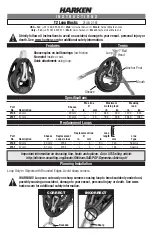
5
• It is important to note that the surfaces of the
motor (cooling fins) and certain parts of the
bearing may get very hot during operation.
• Never cover the ventilation slots or cooling fins
on the motor or on the instrument.
• Avoid knocking and impacting on the lower end
of the shaft and the chuck gear teeth. Even mi-
nor, invisible damage can lead to imbalance and
uneven shaft action.
• Ensure that the stand does not start to move.
• Imbalance of the output shaft, the chuck and
in particular the stirring tools can lead to un-
controlled resonant vibrational behavior of the
instrument and the whole assembly. Glass ap-
paratus and stirrer containers can be damaged
or shattered by this. It can cause injury to the
operator, also can damage the rotating stirring
tool. In this case exchange the stirring tool for
one without imbalance or remedy the cause of
the imbalance.
If there is still imbalance, return it to the dealer
or the manufacturer along with a description of
the fault.
• If the instrument is operated too long in over-
load or if the ambient temperature is too high,
the instrument switches off permanently.
• The machine must only be opened by trained
specialists, even during repair. The instrument
must be unplugged from the power supply be-
fore opening. Live parts inside the instrument
may still be live for some time after unplugging
from the power supply.
Covering or parts that are ca-
pable of being removed from
the unit without accessory
equipment have to be reat-
tached to the unit for safe
operation in order to pre-
vent, for example, the ingress
of fluids, foreign matter, etc..
The operation of a free rotat-
ing shaft end is dangerous.
Therefore, for safety rea-
son, only insert through the
stirring tool over the upper
edge of housing at standstill.
Wear your personal protec-
tive equipment in accor-
dance with the hazard cat-
egory of the medium to be
processed, otherwise there
is a risk of:
- splashing of liquids
- projectile parts
- body parts, hair, clothing
and jewelry getting caught.
Beware of the risk of:
- flammable materials
- glass breakage as a result of
mechanical shaking power.
Reduce the speed if:
- the medium splashes out
of the vessel because the
speed is too high
- the instrument is not run-
ning smoothly
- the instrument begins to
move around because of
dynamic forces
- an error occurs.
Do not touch rotating
parts during operation!
• There may be electrostatic activity between
the medium and the output shaft which
could cause a direct danger.
• After an interruption in the power supply or a
mechanical interruption during a stirring pro-
cess, the unit does not restart automatically.
DANGER
DANGER
DANGER
DANGER
DANGER
WARNING





























